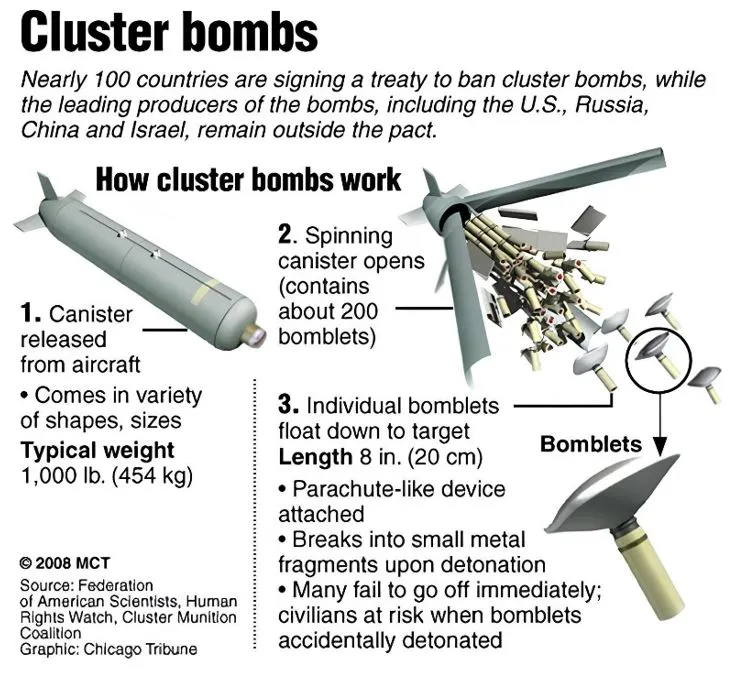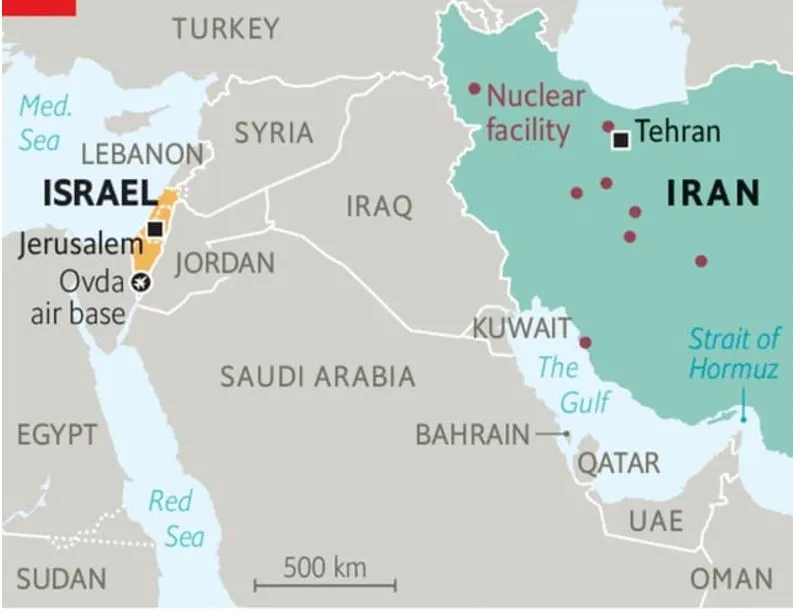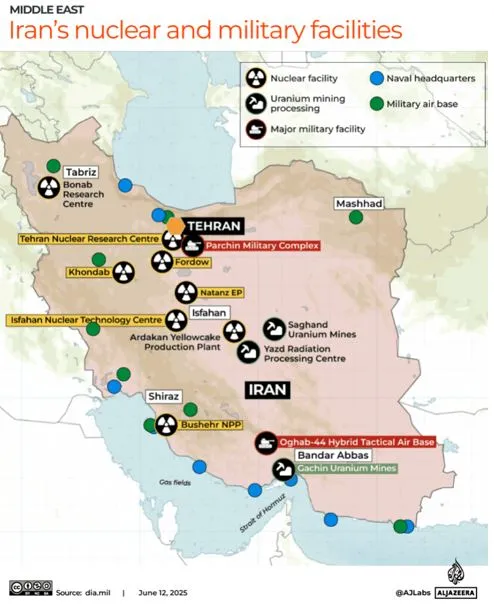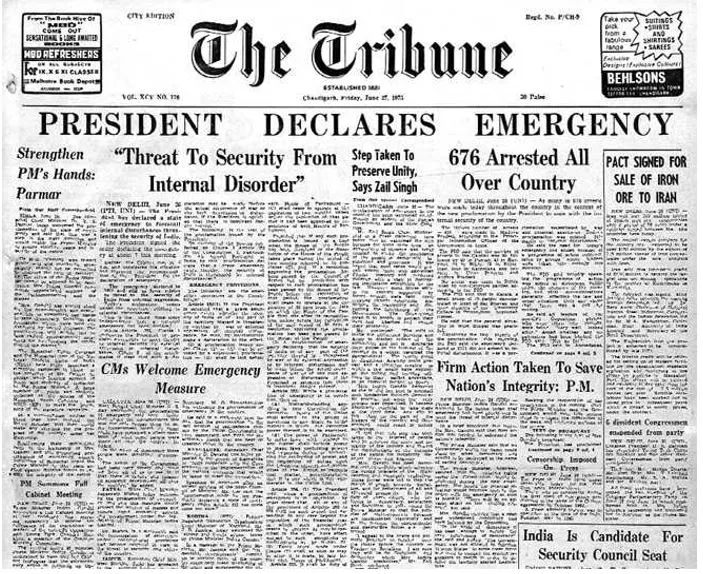

26th June 2025 (28 Topics)
Mains Issues
Context
After 12 days of intense military conflict, a ceasefire was announced between Iran and Israel, bringing temporary relief to the volatile West Asian region. The situation had escalated dangerously with direct missile attacks, targeted assassinations, and the entry of the United States into the conflict.
Iran-Israel Conflict (Brief Background)
- Post-1979 Islamic Revolution, Iran adopted a hostile stance toward Israel, ending earlier diplomatic ties.
- Since then, Israel has accused Iran of secretly developing nuclear weapons and has reportedly carried out covert strikes on Iranian nuclear facilities.
- In retaliation, Iran has supported proxy groups such as Hezbollah (Lebanon), Hamas (Gaza), and the Houthis (Yemen)—collectively known as the “Axis of Resistance”—to launch attacks against Israel.
- In 2024, tensions sharply escalated:
- April: Israel bombed Iran’s consulate in Damascus, Syria, killing several personnel.
- July: Israeli airstrikes killed Hamas leader Ismail Haniyeh during his visit to Tehran and Hezbollah leader Hassan Nasrallah in Beirut.
- April & October: In response, Iran launched massive missile barrages at Israel, most of which were intercepted.
Who gained what?
- United States: US demonstrated military might by striking Iran's nuclear sites.
- It avoided casualties and chose not to escalate further after Iran’s retaliatory strike.
- It positioned itself as a peacemaker, showing strategic restraint.
- Politically, Trump avoided a prolonged war during an election cycle.
- It claimed victory by stating Iran's facilities were “obliterated.”
- Israel: Israel asserted air superiority by striking Iran’s key military and intelligence targets.
- It claimed the assassination of IRGC commanders, including top generals.
- It benefitted geopolitically by bringing the US into direct involvement.
- It gained domestic mileage ahead of elections for PM Netanyahu.
- Iran: Iran projected strength by retaliating against both Israel and the US. It managed to avoid a broader war through calibrated strikes with prior warnings. It retained domestic legitimacy by presenting itself as standing up to global powers.
- Despite damage, Iran denied major losses and emphasized “resistance.”
Iran’s nuclear and military facilities
- The UN’s nuclear watchdog, the International Atomic Energy Agency (IAEA), had accused Iran of enriching up to 400kg of uranium to 60 percent – not far below the 90 percent enrichment that is needed to make weapons.
Underlying Concerns
- The ceasefire is fragile. Uncertainty remains about the extent of Iran's nuclear damage.
- There are worries that Iran may accelerate nuclear development.
- Questions remain about Iran’s uranium stockpile and long-term regional stability.


Mains Issues
Context
A first-of-its-kind trilateral meeting was held in Kunming, China involving Bangladesh, China, and Pakistan. Though informal, it signals an emerging alignment in South Asia that may impact India’s strategic space. Just a few days later, India’s Ministry of External Affairs (MEA) announced that it is open to discussing all bilateral issues with Bangladesh in a “conducive environment”.
What’s changing in Bangladesh's Foreign Policy?
Since the interim regime replaced Sheikh Hasina’s Awami League in August 2024, Bangladesh’s foreign policy has taken a new direction:
- Earlier, Bangladesh maintained a pro-India tilt, ensured that India’s security concerns (e.g., border, insurgency) were addressed, and prioritized India for infrastructure and connectivity projects.
- Now, the interim government is:
- Deepening military and trade ties with Pakistan, despite the legacy of the 1971 Liberation War.
- Actively welcoming Chinese investments and military cooperation, including in strategic areas near India’s Siliguri Corridor.
- Trying to reduce reliance on India and look for new partners in the region, particularly China.
This shift away from India is not just symbolic; it’s institutional and strategic.
What actually happened?
- The meeting was at the official (bureaucratic) level, not at a political or head-of-state level.
- Bangladesh clarified that:
- There was no political agenda or alliance-building.
- It was not intended to target India or any other third country.
Significance of Kunming Trilateral for India
Even if the meeting was informal, there are strategic signals that India must carefully observe:
- China’s Increasing Role in South Asia: China has been using platforms like the China-South Asia Cooperation Forum to engage South Asian countries beyond India (e.g., Nepal, Bangladesh, Sri Lanka, Maldives).
- This is seen as part of Beijing’s strategy to reduce India’s traditional influence in its neighbourhood.
- Pakistan-China Axis with a Third Player: Pakistan is already a close strategic and economically of China (especially under the CPEC – China-Pakistan Economic Corridor). Inclusion of Bangladesh, even informally, adds to China-Pakistan’s regional diplomacy efforts, and may shift balance in regional cooperation formats.
- Bangladesh’s Strategic Autonomy: Bangladesh is trying to balance ties between India (its largest neighbour) and China (its biggest trading partner).
- While it has close civilizational and economic ties with India, it also receives major infrastructure investments from China.
- It’s being careful not to appear aligned too closely with either.
Implications for Regional Groupings
- India is part of SAARC (which is largely dysfunctional due to India-Pak tensions) and BIMSTEC (which excludes Pakistan).
- China is now attempting to shape its own South Asia platform, which could evolve into an alternate cooperation mechanism to India-led regional formats.

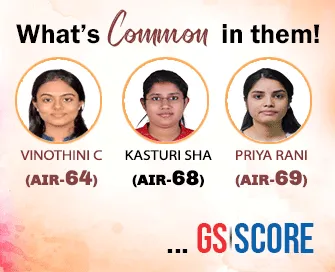
Mains Issues
Context
June 25, 2025 marks the 50th anniversary of the Emergency declared in 1975 — a 21-month period when civil liberties were suspended, the Constitution was altered to expand central power, the media was censored, and mass detentions took place.
Background: What led to the Emergency?
The Emergency was declared in the context of rising political opposition, economic crisis, and a court ruling disqualifying the sitting Prime Minister.
- Economic crisis: India was facing high inflation, unemployment, and food shortages post the 1971 war with Pakistan, global oil crisis (1973), and internal governance failures.
- Political opposition: A powerful opposition movement emerged, led by Jayaprakash Narayan (JP), who called for “Total Revolution (Sampoorna Kranti)” to fight corruption and authoritarianism.
- Court ruling: On June 12, 1975, the Allahabad High Court found Prime Minister Indira Gandhi guilty of electoral malpractice under the Representation of the People Act, 1951, and disqualified her from office for six years.
- The Supreme Court gave a conditional stay, allowing her to remain PM but not vote in Parliament.
- As public protests intensified, Indira Gandhi advised the President to declare a national Emergency.
Constitutional Basis of the Emergency
- On June 25, 1975, President Fakhruddin Ali Ahmed declared an Emergency under Article 352 of the Constitution, citing “internal disturbance” as the reason.
- This was the first peacetime Emergency (previous ones were during wars in 1962 and 1971).
- Article 352 (before 44th Amendment) allowed Emergency to be declared on grounds of war, external aggression, or internal disturbance.
Important Note: The term “internal disturbance” was later replaced with “armed rebellion” in 1978 through the 44th Constitutional Amendment to prevent misuse.
Major Legal and Constitutional Consequences
- Suspension of Fundamental Rights
- Article 358: Automatically suspended Article 19 (freedom of speech, movement, etc.).
- Article 359: Allowed the government to suspend enforcement of rights like equality before law (Art. 14), protection of life and liberty (Art. 21), and protections against arbitrary detention (Art. 22).
- Citizens could not approach courts for redress.
- Preventive Detentions and Arrests: Over 1.1 lakh people were detained, including almost all opposition leaders (JP, Morarji Desai, Vajpayee, Advani). MISA (Maintenance of Internal Security Act) and COFEPOSA were used for arrests without trial.
Constitutional Amendments Passed During Emergency
|
- ADM Jabalpur Case (1976): The Supreme Court ruled that even the right to life could be suspended during Emergency. Only Justice H.R. Khanna dissented, famously stating that life and liberty cannot depend on the mercy of the executive.
- Media Censorship and Control
- Pre-censorship was imposed: newspapers had to submit content to government censors.
- Power to newspaper offices was cut in Delhi.
- News agencies were merged into one: Samachar.
- The Press Council of India was abolished.
- Journalists like Kuldip Nayar were jailed.
- Some newspapers resisted — The Indian Express famously left editorial columns blank in protest.
- Forced Sterilisation Campaign: Promoted as part of population control by Sanjay Gandhi (Indira's son). Over 1.07 crore sterilisations done in two years.
End of the Emergency and Aftermath
- Emergency was lifted on March 21, 1977. In the 1977 General Elections, Indira Gandhi’s Congress was defeated.
- The Janata Party, a coalition of opposition forces, came to power.
- Morarji Desai became the first non-Congress Prime Minister.
Post-Emergency Reforms
- 44th Constitutional Amendment (1978) replaced “internal disturbance” with “armed rebellion” in Article 352. It restored judicial review of Emergency proclamations. It made it mandatory for Emergency to be approved by both Houses of Parliament by a special majority within one month. Also, it strengthened protection for Article 20 and 21, even during Emergency.
- Shah Commission of Inquiry (1977–79): Headed by Justice J.C. Shah, it investigated abuses during the Emergency.
- Findings:
- Mass illegal detentions under MISA.
- Media censorship and intimidation.
- Forced retirements of 25,962 public employees.
- Over 1 crore forced sterilisations; 1,774 linked deaths and many abuses.
Enduring Legacy for Indian Democracy
- The Emergency exposed the vulnerabilities of India’s constitutional setup.
- It showed how institutions (judiciary, media, bureaucracy) can bend under political pressure.
- However, it also demonstrated the resilience of democracy — public backlash led to the defeat of an authoritarian regime through peaceful elections.
- It birthed a generation of opposition leaders (like Lalu Yadav, Ram Vilas Paswan, George Fernandes, Jaitley) and institutional reforms.
Landmark Cases: Judicial Interpretation of Emergency Provisions
|
Conclusion
The 1975–77 Emergency remains a powerful lesson in how democratic safeguards must be preserved at all costs. It reshaped India's constitutional architecture, enhanced checks on executive power, and serves as a reminder that liberty, once lost, is not easily regained.


Mains Issues
Context
During the 25th meeting of the Central Zonal Council (CZC), States were urged to increase the income of Gram Panchayats and formulate rules to support this goal.
Why it is important to make Panchayats financially empowered?
- Financially empowered Panchayats can better deliver local development and implement Centrally Sponsored Schemes (CSS).
- Strengthening Panchayats supports India’s three-tier democratic governance model under the 73rd Constitutional Amendment Act.
Current Sources of Gram Panchayat Income
- Own?Taxes (Own Source Revenue – OSR): Property/House tax, profession tax, vehicle tax, entertainment/fair fees, advertisement tax, leases or cess on markets or local resources
- Own Non?Tax Fees: Water, sanitation, community halls, market licenses, birth/death registration
- Transfers from Central/State: Tied and untied grants via Central & State Finance Commissions, including 15th FC allocation of Rs 2.36?lakh?cr for 2021–26
- Funds from CSS like MGNREGA, PMAY etc., routed through state budgets
- Borrowing (Limited Usage): Municipal bodies have limited borrowing options; under?utilised by Panchayats
- Challenges with Current Model
- OSR per capita is very low (Rs 59/year)
- Own revenues largely untapped—many Panchayats don’t optimally levy taxes/fees
- Heavy dependence on grants, which may be tied and restrict flexibility.
About Panchayat Raj System
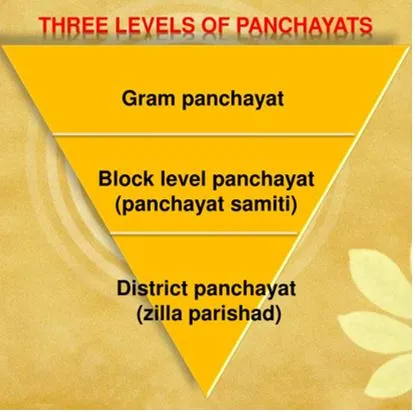 |


Mains Issues
Context
The Union Government has announced that the next decennial Census will be conducted in 2027, and for the first time since Independence, it plans to collect caste data as part of this massive demographic exercise.
- This decision revives the long-standing debate on whether caste enumeration in the Census is feasible, reliable, and effective for achieving social justice and inclusive policy planning.
How is the Census Conducted? (Structure of Census Operation)
The Census in India is conducted in two phases:
- House-listing Phase (Expected: April–September 2026): It included listing all houses/dwelling units and collects data on housing conditions, amenities, and assets.
- Population Enumeration Phase (Expected: 2027): It captures demographic, social, and economic characteristics of individuals (including gender, literacy, employment, disability, migration, etc.).
- Caste enumeration, as per current plan, will be done in this phase.
Why is Caste Being Counted Now?
- The last comprehensive caste enumeration happened in 1931.
- Though the 1941 Census recorded caste, data was not processed due to World War II.
- Post-Independence Censuses only included Scheduled Castes (SCs) and Scheduled Tribes (STs)—not OBCs or general castes.
According to the government, caste data can help bring marginalised groups into the mainstream, enhance targeted welfare policies, and address development disparities between social groups.
Challenges in the Current Caste Enumeration Method
- Limited Scope of Questions: So far, the caste question is only asked to SCs, not to all. Caste-specific social and economic data is not fully captured.
- Lack of Linkage Between Housing and Socio-Economic Status: Since 1991, amenity-related questions (like electricity, water access, etc.) are in the House-listing phase, while caste and personal data are in the Population Enumeration phase.
- The time gap (6–9 months) and different forms make data linking difficult, especially in urban areas or slums.
- Unreliable Employment Data: The question “whether seeking/available for work” is vaguely framed and lacks defined reference periods, resulting in poor data on unemployment by caste.
- Poor Quality of Fertility/Mortality Data: Census collects data on childbirth and survival, but these are better measured through NFHS, and caste-wise analysis is not meaningful here.
- Migration Data is Incomplete: Census data often underreports migrants, making it hard to assess caste-based migration trends.
How Can the Census Be Reformed for Better Caste Data?
- Redesign the Questionnaire: It is important to include all castes (not just SCs) in the caste question. Capture variables linked to education, employment type, income source, and age at marriage to understand inter-caste disparities.
- Shift Housing Data to Population Phase: Transfer questions on housing quality and amenities (currently in house-listing) to the population enumeration form, so they can be directly correlated with caste.
- Make Questions Clear and Measurable: There is need to define reference periods and standards for responses (especially for employment).
- Drop redundant questions (e.g., mobile phone ownership) that add bulk but little analytical value.
- Build Stronger Enumerator Training: Ensure enumerators understand how to ask sensitive caste questions and correctly record answers, reducing biases or errors.
Why is this Important for Policy and Governance?
Without granular caste-wise data, it becomes difficult to:
- Identify the most backward groups who lack access to housing, education, employment, etc.
- Design effective reservation policies and targeted welfare schemes.
- Evaluate the impact of affirmative action and assess socio-economic mobility across castes.
Also, by enabling caste-based disaggregated statistics, India can develop more inclusive developmental indicators for health, education, sanitation, and urban housing.


Mains Issues
Context
Foreign universities are actively planning to set up branch campuses in India, especially in GIFT City (Gujarat) and Navi Mumbai, after the UGC (FHEI) Regulations, 2023, allowed their entry under the National Education Policy (NEP) 2020. This move is expected to reshape India’s higher education landscape.
Why Are Foreign Universities Coming to India?
- Global Financial Pressure on Universities
- In developed countries, declining birth rates have led to falling domestic enrolment in higher education.
- Universities in the UK, US, Canada, and Australia now depend heavily on international students for tuition income.
- Example:
- UK: 22% of students are international
- Australia: 24%
- Canada: 30%
- US: 6% overall, but 27% at Ivy League schools
- Recent Restrictions on International Students
- Australia and Canada have capped student visas.
- UK imposed tougher visa rules in 2024.
- These policies are hurting universities' finances; hence, they are exploring India as a new education market.
Why India is Attractive?
- Large Youth Population & Growing Demand: With over 40 million students, India is one of the largest higher education markets. Gross Enrolment Ratio (GER) is still below 30% — indicating huge untapped potential.
- Rising Affordability: As incomes rise, more Indian families may afford foreign-branded education delivered domestically.
- Low Quality in Existing Institutions: Apart from a handful of elite institutes (IITs, IIMs, AIIMS), many public and private HEIs in India are mediocre. Foreign universities can fill this quality gap.
- Home-based Global Degrees: Students who wish to work in India or cannot afford to study abroad may prefer these branch campuses. This helps in reverse internationalisation — world-class education coming to students, not the other way around.
Key Challenges for Foreign Universities in India
- Price Sensitivity: While India has student numbers, the average Indian family is cost-conscious. High tuition fees may deter mass enrolment in the short term.
- Mixed Global Record of Branch Campuses: Several foreign campuses in Asia and the Middle East have shut down or lost money due to low demand or mismanagement.
- Limited Impact Initially: Even with 10–20 foreign campuses, the number of students served will be marginal compared to India’s total student base.
- Accreditation, Regulation, & Integration: UGC norms allow for academic freedom, but operational issues, cultural differences, and regulatory compliance may still pose barriers.
Governance & Policy Significance
- The NEP 2020 aims to internationalise India’s higher education and bring global standards to local campuses.
- The UGC (FHEI) Regulations, 2023 are a major reform in this direction.
- This move could trigger reforms in domestic institutions, increase competition, and improve standards.
- Over time, it may also help India emerge as a regional education hub, competing with destinations like UAE, Singapore, and Malaysia.


Mains Issues
Context
The UK Parliament's House of Commons narrowly passed the “Terminally Ill Adults (End of Life) Bill” for England and Wales. It seeks to legalise assisted dying under strict conditions. Scotland is considering a separate bill with similar aims. If passed by the House of Lords, it could bring a major legal and ethical shift in how terminally ill patients are treated in the UK.
What is Assisted Dying?
- Assisted Dying: A terminally ill person voluntarily ends their life using a prescribed lethal drug, usually self-administered.
- Assisted Suicide: Helping someone (not necessarily terminally ill) to end their life.
- Euthanasia: A physician deliberately ends a person’s life to relieve suffering (can be voluntary or non-voluntary).
Provisions of the New Bill (England & Wales)
- The bill permits assisted dying if:
- The person is over 18, a resident of England/Wales, and has been with a registered GP for at least 12 months.
- Diagnosed with a terminal illness with less than six months to live.
- Declares their wish twice (with proper witness), free from coercion.
- Approved by two independent doctors, and a three-member panel (judge, psychiatrist, social worker).
- A 14-day waiting period is required before proceeding.
- The person must self-administer the prescribed medication.
- Coercion is punishable with up to 14 years in prison.
- Additional safeguards added later:
- Review of palliative care services within a year.
- No conversations with minors (under 18) about assisted dying.
- Ban on advertising assisted dying services.
- Opt-out option for health professionals.
|
Ethical & Social Opposition |
Support for the Bill |
|
|
Status in Other Countries:
Many countries have taken different approaches to assisted dying or euthanasia:
- Switzerland: The first country to legalize assisted dying in 1942.
- USA: States like Oregon passed the Death with Dignity Act in 1997, allowing mentally sound adults with terminal illness to end their lives with self-administered drugs.
- Canada: Since 2016, Canada's Medical Assistance in Dying (MAID) law allows both terminal and non-terminal patients (if the condition is grievous or irremediable) to seek help in ending their lives.
- Netherlands and Belgium: Both countries have comprehensive euthanasia laws, with Belgium extending euthanasia to minors with parental consent.
- Spain and Germany: These countries have passed laws, but their implementation is at various stages.
- France and Ireland: These countries are still deliberating on assisted dying legislation.
- India (Karnataka): Karnataka has taken a landmark step in facilitating the right to die with dignityto implement the Supreme Court’s 2023 directive, becoming the first state to do so.
- This move is in line with the Supreme Court’s 2023 ruling, which affirmed that the Right to Life under Article 21 of the Constitution also includes the right to die with dignity (Withdrawal of Life-Sustaining Therapy (WLST)).


Mains Issues
Context
Following the tragic Air India AI-171 crash in Ahmedabad, which killed 241 people on board and 30 on the ground, the Directorate General of Civil Aviation (DGCA) has launched a comprehensive safety audit of the entire aviation sector.
What is the current state of India’s aviation sector?
- India is now the third-largest domestic aviation market globally, after the United States and China.
- With over 150 functional airports, including both international and regional ones, the sector has expanded rapidly in the last two decades.
- Airlines like IndiGo, Air India, SpiceJet, Vistara (merged with Air India), and Akasa Air dominate the skies.
- A significant chunk of the aviation activity happens in metro cities, but schemes like UDAN (Ude Desh ka Aam Nagrik) are making regional connectivity affordable and accessible for common citizens.
What is the need for Stronger Oversight?
- India’s aviation sector has faced growing safety and regulatory challenges.
- The tragic Air India AI-171 crash in Ahmedabad exposed several weaknesses in the existing system.
- Investigations pointed towards issues like poor oversight of crew rest hours, fatigue management, and fragmented auditing.
What is the DGCA Doing?
- DGCA will conduct a 360-degree safety audit of the aviation ecosystem, which includes:
- Safety Management Systems (SMS)
- Operational efficiency
- Compliance with international norms (ICAO SARPs)
- Training and crew duty oversight
- For the first time, audits will be done holistically, not in silos (i.e., not just by one directorate at a time). Multidisciplinary teams will inspect all domains — airworthiness, licensing, air navigation, etc.
- ICAO SARPs: The audit aligns with Standards and Recommended Practices of the International Civil Aviation Organization (ICAO).
- India is a member of the International Civil Aviation Organization (ICAO).
Current Governance Reforms and Issues
- Privatization of Air India (2022) to improve efficiency and reduce fiscal burden
- UDAN Scheme: Regional connectivity at subsidized rates (launched 2017)
- GAGAN and ADS-B: Indigenous air navigation systems for improved flight safety
- Bilateral Air Service Agreements: Liberalized access to foreign carriers
Governance of Indian AviationThe Ministry of Civil Aviation (MoCA) is the nodal ministry that formulates national civil aviation policies, manages bilateral air service agreements, and promotes airport infrastructure. The actual implementation and regulation are handled by specialized agencies:
Legal and Regulatory Framework
|


Mains Issues
Context
A Union Health Ministry report has highlighted critical gaps in India’s organ transplantation system, citing issues like infrastructure shortages, lack of trained personnel, inadequate ICU capacity, and financial burdens on patients.
Key Findings:
- Severe transplant gap: Only 13,476 kidney transplants were performed last year, against the annual need of over 1 lakh transplants in India.
- Lack of specialised infrastructure: Most government hospitals lack dedicated transplant OTs and ICUs. ICU beds are heavily burdened with trauma/general care patients. Inadequate beds for maintaining brain-stem dead (BSD) donors.
- Absence of labs: There is lack of in-house Human Leukocyte Antigen (HLA) testing labs in many centres (including AIIMS branches) is causing delays. Dependence on external labs disrupts the timely conduct of transplants.
- Human resource shortages:
- Shortage of transplant-trained specialists: nephrologists, transplant surgeons, neurologists, anaesthetists, intensivists.
- Frequent transfer of trained personnel affects continuity.
- Lack of incentives for transplant teams (nurses, coordinators, surgeons).
- Financial Burdens on Patients: Transplants need lifelong immunosuppressant drugs—often costing lakhs annually. Current health schemes cover only 1st-year costs, leaving patients exposed thereafter.
- Ayushman Bharat PMJAY doesn’t fully cover liver/heart transplants or post-op drugs, making them unaffordable for poor patients.
Recommendations from the Report:
- There is need to expand funding for transplant infrastructure, including ICUs and OTs.
- Incentivise transplant teams on a case-by-case basis.
- Set up dedicated transplant centres in more public hospitals.
- Include liver and heart transplants and lifelong drug coverage under Ayushman Bharat PMJAY.
Fact Box:Organ Transplantation
National Organ and Tissue Transplant Organization (NOTTO)
|

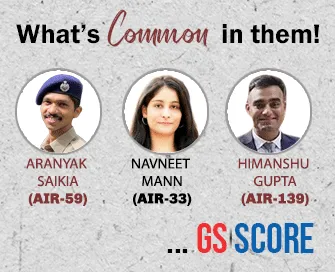
Mains Issues
Context
The International Monetary Fund (IMF) is best known for helping countries in economic crises. But a lesser-known question is: How does the IMF itself get the money to lend? Recently, IMF explained its unique self-financing model—a system that does not rely on taxpayer money or government grants but still supports nearly USD 1 trillion in lending capacity.
How the IMF is Financed and Why it Matters?
- Funding Source: IMF is funded through member quotas based on each country’s economic size. No taxpayer funding is involved.
- Quota Role: Quotas determine financial contribution, borrowing limit, and voting power of each member.
- IMF is a credit union of countries. Its members (currently 191 countries) contribute funds and, in return, can borrow during a crisis, and earn interest on their contributions when the money is lent to others. These contributions are called "quotas".
- Reserve Asset: Member contributions are treated as interest-bearing and liquid reserve assets.
- Lending Capacity: IMF’s total lending capacity is approx. USD 1 trillion, pooled from member resources.
- Creditors' Benefit: Creditor countries earn market-based interest on funds lent. USD 5 billion earned in 2024 by 50 countries.
- Borrowers’ Benefit: Crisis-hit countries get temporary, low-interest loans with macroeconomic reform conditions.
- Zero Credit Loss: IMF has never faced loan default or loss on lending.
- No Development Loans: IMF provides macro-stabilisation, not infrastructure/project loans (unlike World Bank).
- Operational Costs: Operational costs are covered via lending income and investments; no member budget appropriations.
Why Does It Matter for the World Economy?
The IMF’s unique financial system enables it to:
- Act as a global financial safety net, preventing economic crises from spreading.
- Support global financial stability by intervening early in crises.
- Promote international cooperation, since economic instability in one country can affect others through trade, migration, and capital flows.
For example: If a country defaults on loans or faces hyperinflation, it could trigger currency crashes, investor panic, or even regional instability. IMF support helps prevent such outcomes.


Mains Issues
Context
In 2025, India is facing slowing economic growth, declining inflation, and rising unemployment. To revive the economy, the government and the Reserve Bank of India (RBI) have both taken expansionary steps—through tax cuts and interest rate reductions. However, this simultaneous expansion by both fiscal and monetary arms has raised concerns about policy coordination and long-term macroeconomic stability.
The expansionary steps
- Monetary Policy: The RBI cut the repo rate in two successive policy meetings: April 2025: -25 basis points, June 2025: -50 basis points to boost private investment, increase credit growth, and support GDP growth (forecast at 6.5% for 2025–26).
- Reason: Inflation has fallen (3% in June 2025), giving the RBI space to cut rates and stimulate demand.
- Fiscal Policy: In February 2025, the government announced income tax cuts to increase household disposable income, raise consumption demand and stimulate growth.
Why is this Policy Mix Problematic?
Expansionary Policies Need Careful Coordination
- Fiscal and monetary policies both influence aggregate demand.
- Fiscal expansion means more spending or investment by the government or consumers.
- Monetary expansion makes loans cheaper, encouraging more private investment.
- If both policies are expansionary at the same time, they risk the following:
- Overheating the economy
- Rising inflation
- Higher fiscal deficits if the economic growth does not keep pace
- Global learning: In US & UK, tax cuts were neutralised by central banks refusing to cut rates fearing inflation. This shows how uncoordinated policies can cancel each other out or create imbalances.
What are the current concerns in India?
- Muted Economic Response: Despite tax cuts, credit growth fell to 9% in May (lowest in 3 years). Unemployment rose from 5.1% in April to 5.6% in May. This suggests:
- Weak aggregate demand
- Income tax cuts have not yet stimulated spending
- Time Lag vs. Forward-Looking Consumers: Economic theory assumes people adjust their spending based on expected gains (forward-looking). But the delay in response raises doubts:
- Are people waiting for actual income before spending?
- If so, a delayed inflation spike could come once spending picks up.
What Happens If Growth Doesn’t Rise?
- Fiscal deficit may widen if GDP doesn't rise, tax collections fall, and deficit rises. To control deficit:
- Government may cut spending (especially revenue expenditure).
- That could hit vulnerable populations, as welfare programs may be downsized.
- If both consumption and investment spike later, RBI may be forced to reverse its rate cuts, tightening monetary policy sharply.
Structural Risks
- Weak Demand Structure: Even with expansionary policies, demand isn’t picking up. This points to larger structural issues:
- Inequality in income distribution
- Rising corporate profits, stagnant wages
- Weak wage-led demand for goods/services
- Role of the State: In such cases, relying solely on markets may not work. Sustained state intervention is needed to:
- Boost wages and consumption
- Strengthen public infrastructure
- Protect social spending from fiscal consolidation pressures
Fact Box:Expansionary Policies
|


Mains Issues
Context
On June 25, 2025, Group Captain Shubhanshu Shukla became the second Indian astronaut (after Rakesh Sharma in 1984) to travel to space. He is the first Indian to go to the International Space Station (ISS) as part of the Axiom Mission 4 (Ax-4) — marking India’s return to human spaceflight after 41 years.
About the Mission
- Ax-4 is a commercial mission by Axiom Space in collaboration with NASA, ISRO, and international partners.
- Launched via SpaceX Falcon 9 rocket with the Crew Dragon spacecraft “Grace” from Kennedy Space Center, Florida.
- Four-member international crew:
- Shubhanshu Shukla (India) – Mission Pilot
- Peggy Whitson (USA) – Commander
- Tibor Kapu (Hungary)
- Slawosz Uznanski-Wisniewski (Poland)
- Objective: 14-day stay on ISS to conduct 60+ scientific experiments in microgravity.
- Axiom Mission 4 will carry out approximately 60 scientific experiments and outreach activities involving 31 countries, including India, the US, Poland, Hungary, Saudi Arabia, Brazil, Nigeria, UAE, and several European nations.
- The research will span areas like human health, space agriculture, microgravity physics, and climate technology.
- This mission also aims to demonstrate the growing role of private companies in facilitating international human spaceflight and the expanding use of the ISS for commercial and diplomatic initiatives.
Significance of the Mission
- Revival of Indian Human Spaceflight: It is the first step towards Gaganyaan Mission (planned 2027). It is symbolic and strategic return to space after 4 decades.
- ISRO-NASA Collaboration: It fulfils joint commitment from earlier Indo-US summits. Coordination on scientific experiments, astronaut training, and space diplomacy.
- Science and R&D: Experiments on food & nutrition, microgravity-based seed germination (methi, moong), and human physiology. Involvement of Department of Biotechnology (DBT) and ISRO.
- Representation and Legacy: Shukla is a 39-year-old Indian Air Force pilot with 2,000+ hours of flying experience. He was selected in 2019 for Gaganyaan training (India's astronaut corps).


Mains Issues
Context
A recent landmark study by researchers at the University of Notre Dame (USA) and partners in four African countries (Cameroon, Ethiopia, Kenya, Malawi) revealed that nearly 1 in 5 chemotherapy drug samples failed quality standards. Of the 17 implicated manufacturers, 16 are Indian.
Key-findings of the Study
- 189 drug samples of 7 essential cancer drugs were tested (including cisplatin, cyclophosphamide, methotrexate, etc.).
- 20% samples failed quality tests:
- Some had too little active ingredient (as low as 25%).
- Others had too much, risking overdose and organ toxicity.
- Several samples from the same blister pack showed inconsistent dosage, indicating poor manufacturing quality.
Why this is alarming?
- The chemotherapy drugs are used to treat common cancers: breast cancer, leukaemia, ovarian cancer, etc.
- Generic chemotherapy drugs are lifelines in low- and middle-income countries, where alternatives are unaffordable.
- Patients in LMICs (low- and middle-income countries) pay up to 58% of cancer drug costs out-of-pocket (vs. <2% in high-income countries).
- The poorest patients suffer most when drugs fail or run out due to faulty batches.
- Indian pharma firms, though critical to global health access, face growing scrutiny for quality concerns.
- Poor-quality drugs can lead to:
- Treatment failure (if under-dosed).
- Severe side effects or death (if overdosed).
- Loss of trust in healthcare systems.
Key Countries and Companies Involved
- India: World's largest generic drug producer; major source of the failed drugs.
- Ethiopia and Malawi: Countries where doctors reported unexpected treatment failures and toxicity symptoms in patients.
- Venus Remedies, Zuvius Lifesciences, United Biotech, among others, were named in the report.
- Intas Pharmaceuticals, previously found falsifying records, had gained dominant market share in the U.S.
Systemic Issues Highlighted
- Weak Global Regulatory Oversight: 70% of countries lack capacity to test drug quality. Even U.S. FDA admitted its overseas inspections are inadequate.
- Lax Domestic Monitoring (India): Companies with repeated quality violations (e.g., Zee Laboratories) face few consequences: India’s drug regulator rarely discloses timelines or penalties for substandard production.
- WHO Limitations: WHO’s essential medicines list only recently expanded to cancer drugs (post-2019). WHO quality certification is reportedly misused or manipulated by some companies.
- Economic Pressure: Price-cutting incentives often push manufacturers to cut corners in manufacturing or ingredient sourcing.
Required Measures:
- Tighter international regulation and mandatory random testing of generic drugs, especially cancer medicines.
- Stronger domestic oversight in India, including public disclosure of penalties, blacklisting, and reforms in CDSCO functioning.
- Expand the WHO essential medicines list to include more critical cancer drugs.
- Push for greater transparency and accountability in global drug procurement chains (especially via UN agencies).
Fact Box: About CancerCancer is caused by mutations in genes that disrupt normal cell growth and death, leading to uncontrolled cell division and tumour formation. Chemotherapy drugs aim to stop this process by targeting and killing cancer cells, while sparing normal cells as much as possible.
|


Mains Issues
Context
A number of organisations in Assam protested a proposed 55 MW hydropower project on the Kulsi River, jointly planned by the Assam and Meghalaya governments.
About the Project
- It is a joint 55-MW hydropower and irrigation project planned at Ukiam, near the Assam-Meghalaya border.
- It is located close to tribal forest villages and ecologically sensitive zones.
- Key Issues Raised
- Environmental Concerns: It is threat to Gangetic River Dolphin habitat (an endangered species and India’s national aquatic animal).
- It is a risk to 12 wetlands, including Chandubi Lake (a major tectonic lake, 3 km from the dam site).
- Impact on Livelihoods: There is potential displacement of 19 villages (forest and revenue villages).
- Violation of Tribal Land Rights: Villagers (Rabha, Garo, Khasi communities) lack formal land titles, though they’ve applied under the Forest Rights Act, 2006.
Kulsi River
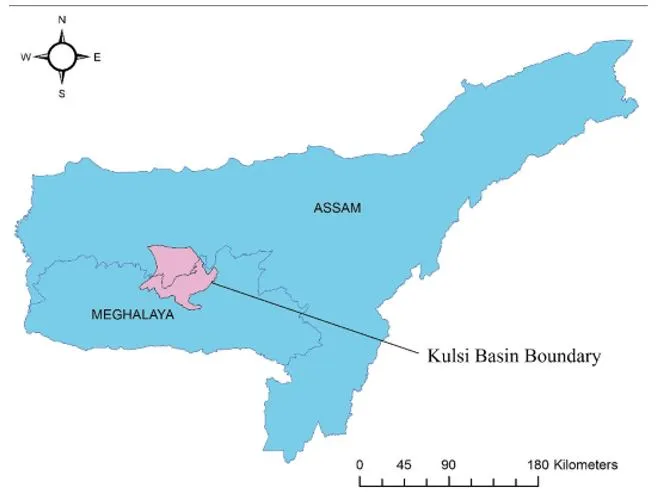 |


Prelims Articles
Context
In a recent incident, a sudden flash floods triggered by cloudbursts occurred in the Kangra and Kullu districts of Himachal Pradesh.
What is a Flash Flood?
- A flash flood is a sudden and intense flood that occurs within minutes or hours of heavy rainfall or a sudden release of water.
- It is typically localized and happens with little or no warning.
- Flash floods are extremely dangerous due to their speed and unpredictability.
- They are common in hilly or mountainous terrains, such as the Himalayas, where narrow valleys, steep slopes, and unplanned construction increase vulnerability.
Factors Responsible for Flash Floods in Himachal Pradesh
CloudburstA cloudburst is an extreme and sudden rainfall event, where more than 100 mm of rain falls in less than an hour over a small area.
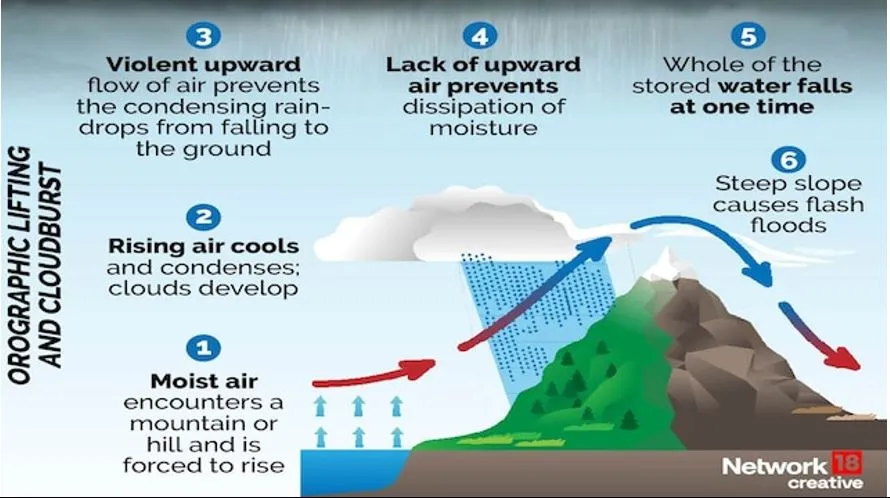 |
- Topography: The steep and fragile mountain slopes of Himachal Pradesh accelerate the downhill movement of water. River valleys like the Beas and Manuni Khad act as channels for fast-moving water.
- Cloudburst Events: Sudden, high-intensity rainfall over small areas causes water accumulation in narrow mountain streams.
- Glacial and Monsoonal Interactions: June to September is the peak monsoon season; melting snow combined with monsoon rains increases water volume in rivers.
- Land Use Changes: Construction near riverbeds, hill-cutting for roads, hydropower projects, and tourism infrastructure disrupt natural drainage.
- Dam Regulation and Warnings: Release of water from dams (like Panhoh Dam) adds to river discharge, especially if not communicated in advance.
- Climate Change: Increasingly erratic weather patterns and rising sea surface temperatures have made cloudbursts more frequent and intense.
- IPCC reports have indicated more extreme rainfall events in the Himalayas due to global warming.

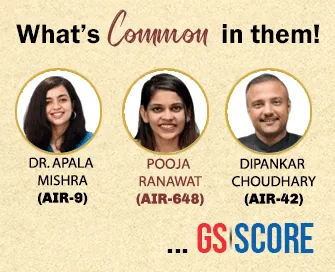
Prelims Articles
Context
India has, for the first time, entered the top 100 countries in the UN Sustainable Development Goals (SDG) Index 2025, securing the 99th rank out of 193 nations, as per the UN Sustainable Development Solutions Network's latest Sustainable Development Report.
Key-Findings of the Index
- Only 17% of SDG targets are on track globally.
- Progress is stalling due to conflicts (e.g., Ukraine, Gaza, Iran–Israel); structural economic challenges; limited fiscal space in low-income countries
- Nordic nations dominate the top rankings:
- 1st: Finland
- 2nd: Sweden
- 3rd: Denmark
- 19 of the top 20 are European
- The US ranked 44th overall but 193rd (last) in SDG commitment to multilateralism for the second year.
- Yet even top countries struggle with climate (SDG 13) and biodiversity (SDG 15) due to overconsumption.
|
Positive Trends Noted |
Negative Trends & Reversals |
|
|
- India’s Performance: India ranked 99th out of 193 countries on the 2025 SDG Index, with an overall score of 67/100. This is the first time India has entered the top 100 — a symbolic milestone.
- Among regional peers:
- China: 49th (Score: 74.4)
- Bhutan: 74th (70.5)
- Nepal: 85th (68.6)
- Bangladesh: 114th (63.9)
- Pakistan: 140th (57)
- Maldives: 53rd, Sri Lanka: 93rd
About the Index
|


Prelims Articles
Context
With Bihar Assembly Elections due later this year, the Election Commission (EC) is preparing for a house-to-house verification of the electoral rolls to ensure the accuracy, transparency, and legal sanctity of the electoral roll through physical verification and data cross-checking.
Why is Voter Roll Verification Important?
The EC highlighted that electoral rolls need continuous updating due to:
- Mass Migration: In 2024 alone, over 3.15 crore changes were made to rolls, including:
- 26 lakh residence shifts
- 32 crore corrections (like name, age, gender, photo)
- First-time Voters: Those turning 18 years are regularly added to the rolls.
- Deaths Not Reported: Unreported deaths result in undeleted entries, weakening electoral integrity.
- Illegal/Foreign Voters: EC has flagged and deleted ineligible foreign nationals.
- Polling Station Rationalisation:
- Each polling booth is capped at 1,200 voters
- No voter should travel more than 2 km to vote.
Legal and Constitutional Basis
|

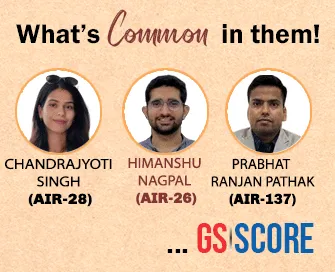
Prelims Articles
Context
The Madras High Court has summoned five senior IAS officers in a contempt of court case for allegedly failing to implement its earlier order.
What is Contempt of Court?
- Contempt of Court refers to any act or omission that:
- Disrespects the authority or dignity of the court, or
- Obstructs the administration of justice.
- There are two types under Contempt of Courts Act, 1971:
- Civil Contempt: Willful disobedience to any judgment, decree, direction, order, or writ of the court.
- Example: Not implementing a court's order, as in this case.
- Criminal Contempt:
- Scandalizing or lowering the authority of the court,
- Prejudicing judicial proceedings, or
- Obstructing the administration of justice.
Constitutional ProvisionThere are two Articles in the Constitution of India which talk about the Contempt of Court and these are Article 129 and Article 142(2).
|


Prelims Articles
Context
The Goods and Services Tax (GST) Council is set to meet in July 2025—over six months after its last meeting in December 2024—to discuss important changes, including:
- Reducing or restructuring the 12% GST tax slab, and
- Relief for service intermediaries, particularly in IT and export services.
What is the issue with the 12% Slab?
The GST Council is considering minimising or possibly eliminating the 12% slab.
- Simplification Goal: Reducing tax slabs from 5 to 4 (0%, 5%, 18%, 28%) will simplify the tax system. This could make compliance easier, reduce classification disputes, and improve tax efficiency.
- Likely Moves: Some goods currently at 12% may be moved down to 5% (e.g., basic processed foods). Some items from 18% may shift to 12%, if they are now seen as daily-use products.
- Consumer Behaviour Shift: Items like toothpaste and soap, once considered discretionary, are now essential due to rising per capita income. They may be moved to lower slabs to reflect this change.
- Impact on Manufacturers: If items move from 12% to 5%, manufacturers may lose Input Tax Credit (ITC).
- ITC is a refund mechanism for taxes paid on inputs. At 5%, this benefit is often not available, making manufacturing costlier.
What about Service Intermediaries?
- A key item on the agenda is to review GST on service intermediaries, especially Indian branches of multinational companies (MNCs).
GST Rate Structure (As of Now)India’s GST currently has a multi-tier rate structure, which includes:
|
- A service intermediary is an entity that facilitates or arranges a service between a provider and consumer but does not supply the service itself.
- Example: Firm X (US-based) signs a global contract. Its Indian arm (Firm Y) executes the work and gets paid by Firm X. Under GST rules, Firm Y is treated as intermediary, taxed at 18%, even though it's exporting a service.
- Problem: These services are technically exports (which should be zero-rated, i.e., no GST). But under current GST law, intermediary services are taxed, leading to:
- Higher costs for Indian service providers
- Double taxation (Indian importer pays GST on full value, including intermediary cost)
- Tax burden on such services is estimated to be around Rs 3,500 crore annually.
Goods and Services Tax (GST) Council
|


Prelims Articles
Context
The growth of India’s eight core industries, which form the backbone of the industrial sector, slowed to just 0.7% in May 2025, the lowest in the past nine months. This comes after already weak performance in April (1%). The biggest concern is that half of the core sectors saw contraction, including electricity, natural gas, fertilisers, and crude oil.
What are the Core Sectors?
|
Key findings on core sector growth for May 2025:
- Core sector growth fell to 0.7%, the lowest in 9 months, indicating industrial slowdown.
- Electricity output contracted 5.8%, worst since June 2020.
- Natural gas (-3.6%) and crude oil (-1.8%) continued their decline.
- Fertiliser production dropped sharply by 5.9%.
- Cement (+9.2%) and steel (+6.7%) showed strong recovery due to infra push.
- Refinery products rebounded with 1.1% growth after contraction in April.
- Coal growth slowed to 2.8%.
- Early monsoon rains disrupted electricity and mining.
- Industrial growth (IIP) may fall to 1.5–2% in May.


Prelims Articles
Context
According to the UNCTAD World Investment Report 2025, FDI inflows to India declined by 1.8% in 2024, signaling a reduced role of foreign investment in India’s development and capital formation.
Key Highlights:
- FDI made up just 3% of India’s total capital formation in 2024, down from 8.8% in 2020, reflecting a steep decline in foreign investment’s contribution to India’s development financing.
- India attracted USD 27.6 billion in FDI in 2024 — nearly half of what it received in 2020 and 8% lower than 2023 levels.
- The cumulative stock of FDI in India was 14% of GDP in 2024, down from 9% in 2020.
- Domestic sources have filled the gap. Capital formation from non-FDI sources has remained strong, especially in sectors like semiconductors and metals.
- India received 80% of South Asia’s FDI, showing continued investor interest relative to its neighbours.
- India saw capital expenditure projections increase by over 25%, reaching USD 110 billion, nearly one-third of all such projections in Asia.
Foreign Direct Investment (FDI)
|


Prelims Articles
Context
A recent report has highlighted how cybercriminals are increasingly using 'mule bank accounts' to launder stolen or illicit funds, making it difficult for authorities to trace and disrupt online financial fraud networks.
What are Mule Bank Accounts?
- Mule bank accounts are legitimate bank accounts (often KYC-compliant) that are used by criminals to receive, move, or withdraw illegally obtained money.
- These accounts are usually opened by unsuspecting individuals (called "money mules") who are either tricked, paid, or coerced into allowing their bank accounts to be used for criminal purposes.
- In some cases, fraudsters open accounts in other people's names (through identity theft), or convince people through online job scams to transfer money on their behalf.
- Key challenge: Because these accounts appear genuine and follow proper documentation, it becomes very hard for law enforcement to identify them as part of money laundering or cyber fraud networks.


Prelims Articles
Context
The Chhattisgarh government has sought help from the Union Tribal Affairs Ministry after its own State Forest Department stalled implementation of Community Forest Resource (CFR) Management Plans. The conflict is over who has the authority to initiate, manage, and coordinate CFR plans: Gram Sabhas (under FRA, 2006) or the Forest Department.
What are Community Forest Resources (CFRs)?
- Community Forest Resources are recognised under Section 3(1)(i) of the Forest Rights Act, 2006.
- CFRs refer to forests customarily used and managed by forest-dwelling Scheduled Tribes (FDSTs) and Other Traditional Forest Dwellers (OTFDs).
- CFR Management Plans aim to ensure:
- Sustainable forest use,
- Livelihood security, and
- Community-based conservation.
What Do Tribal Ministry Guidelines Say?
- MoTA’s 2023 CFR Management Guidelines (based on FRA, 2006) clearly state:
- Gram Sabhas and their CFR Management Committees (CFRMCs) have full authority to:
- Prepare, approve, and implement CFR plans.
- Only after approval should the Forest Department be consulted.
- Forest officials can be co-opted by Gram Sabhas, not vice versa.
- Any alignment with NWPC should be as deemed necessary by the CFRMC, not imposed.
- Gram Sabhas and their CFR Management Committees (CFRMCs) have full authority to:
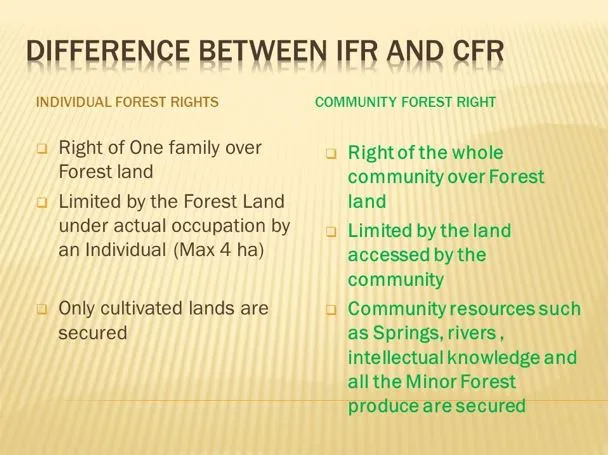


Prelims Articles
Context
A critically endangered leopard has been captured on camera traps in the Chittagong Hill Tracts of Bangladesh, near the India–Bangladesh–Myanmar border.
About the Species:
- Scientific Name: Panthera pardus
- They are the smallest of the large cats, which includes lions, tigers, and jaguars.
- Habitat: Leopard habitats include forests, subtropical and tropical regions, savannas, grasslands, deserts, and rocky and mountainous regions. They can live in both warm and cold climates. Of all the big cat species, leopards are the only known species that live in both desert and rainforest habitats.
- Geography: Their range covers a large stretch of Africa, parts of the Middle East, and Asia, including China, India, and eastern Russia.
- India is home to an estimated 13,874 leopards, with Madhya Pradesh home to the highest population at 3,907.
- Conservation status:
- IUCN Global Status: Vulnerable
- Status in Bangladesh: Critically Endangered (Population possibly non-viable)
- Key Threats:
- Habitat Loss (deforestation, development)
- Prey Depletion
- Poaching & Human-Wildlife Conflict



Prelims Articles
Context
CAR T-cell therapy is gaining attention in India and globally as a revolutionary, personalised treatment for cancer, particularly blood cancers like leukaemia and lymphoma. Recent trials, including one funded by ICMR at CMC Vellore, show its potential to be developed and manufactured within Indian hospitals, improving both accessibility and affordability.
What is CAR T-cell Therapy?
- CAR T-cell therapy stands for Chimeric Antigen Receptor T-cell therapy—a form of immunotherapy that modifies a patient’s own immune cells to fight cancer.
- How it works:
- T-cells, a type of white blood cell, are collected from the patient’s blood (through a process called leukapheresis).
- In the lab, the T-cells are genetically modified to express CAR (Chimeric Antigen Receptors). These receptors help the T-cells recognize cancer cells.
- The modified cells—now called CAR T-cells—are multiplied and then infused back into the patient’s bloodstream.
- These engineered T-cells seek and destroy cancer cells with precision.
- Who can benefit from it? Currently, CAR T-cell therapy is approved for patients with Acute Lymphoblastic Leukaemia (ALL), Non-Hodgkin Lymphoma (NHL), Multiple Myeloma
- Side Effects to Be Aware Of
- Cytokine Release Syndrome (CRS): A strong immune response that can cause high fever, low blood pressure, or breathing issues.
- ICANS (Immune Effector Cell-associated Neurotoxicity Syndrome): Can lead to confusion, headaches, or coordination issues.
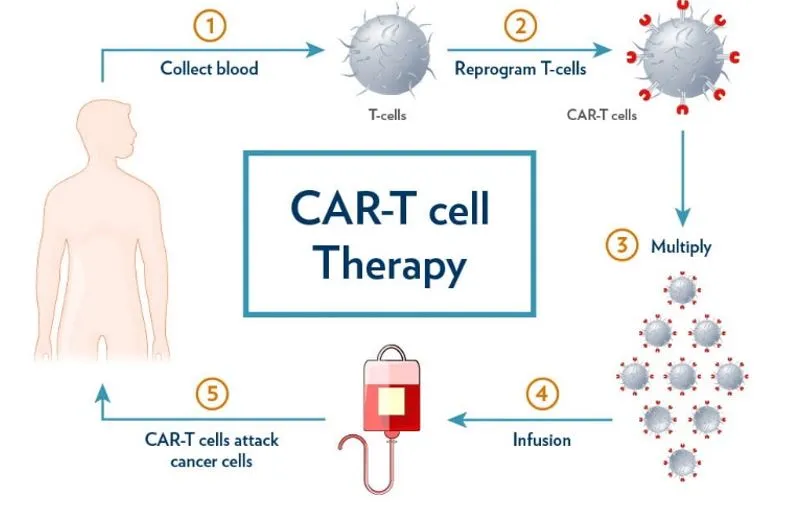


Prelims Articles
Context
In a medical first in India, a newborn in Kerala’s SAT Hospital, Thiruvananthapuram, is being treated before symptoms appear for Spinal Muscular Atrophy (SMA) — a rare genetic neuromuscular disorder. The treatment was made possible due to prenatal genetic screening which identified that the infant carries the SMN1 gene mutation linked to SMA.
What is Spinal Muscular Atrophy (SMA)?
- Spinal Muscular Atrophy (SMA) is a hereditary disorder affecting motor neurons — the nerve cells that control muscle movement.
- It leads to progressive muscle weakness and can be life-threatening, especially in infants.
- It is caused by mutations in the SMN1 gene, usually inherited from both parents.
- It is currently incurable, but early treatment can delay or reduce symptom severity.
- What makes this case special? The mother, an SMA patient, underwent prenatal screening, which detected the SMN1 mutation in the foetus. Choosing to continue the pregnancy, she enabled doctors to begin Risdiplam treatment within three weeks of birth, before any symptoms appeared—a rare, early intervention in India.
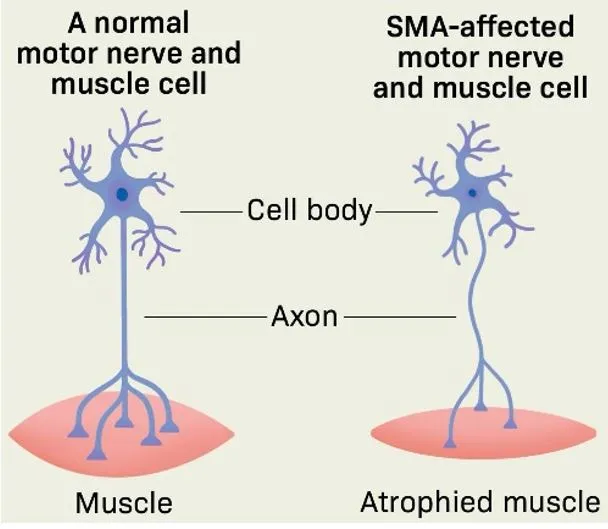
About Risdiplam
|


Prelims Articles
Context
The Indian Navy will commission INS Tamal, a stealth multi-role frigate in Kaliningrad, Russia. It marks a historic milestone as the last warship India will import, with future warships being built indigenously under Atmanirbhar Bharat and Make in India.
What is INS Tamal?
- INS Tamal is a stealth, multi-role frigate — designed for naval combat in sea and land attack roles.
- It is the eighth and final warship of the Krivak-class (also called Tushil-class) India has procured from Russia.
- Built at: Yantar Shipyard, Kaliningrad, Russia
- Length: 125 meters
- Displacement: 3,900 tonnes
- Commissioning Fleet: Western Naval Command (Sword Arm of Indian Navy)
- Crew Strength: Over 250 trained personnel
- Weapon Systems:
- BrahMos Supersonic Cruise Missiles (Range: 290–450 km)
- Anti-air, anti-surface, and anti-submarine capabilities
- Helicopter Integration: It can deploy Kamov-28 and Kamov-31 helicopters for surveillance and anti-submarine warfare
- Stealth Profile: Infrared signature reduction and radar cross-section minimisation make it difficult to detect
- Indigenisation Milestone:
- Contains 26% indigenous components
- Equipped with 33 Made-in-India systems
- Features BrahMos cruise missile, developed in India-Russia collaboration
- INS Tamal is India’s last foreign-built warship, symbolising the transition to self-reliance in naval defence production.
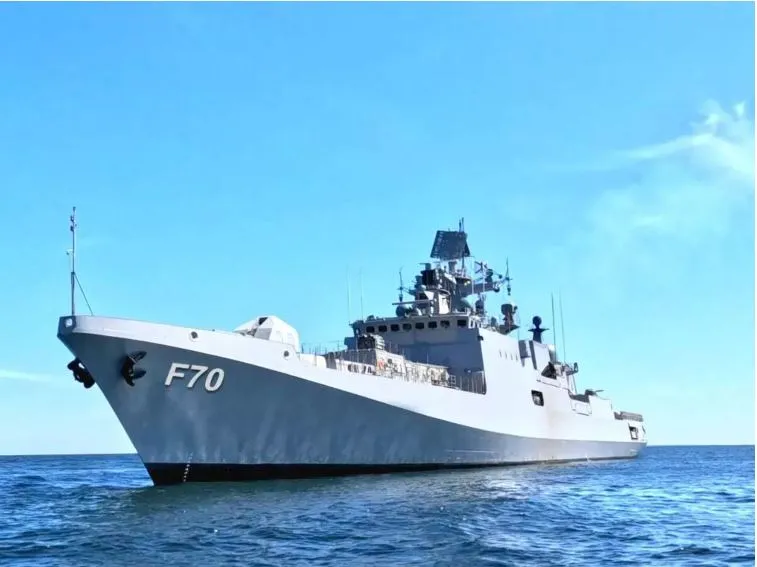


Prelims Articles
Context
Iran fired a missile containing a cluster bomb warhead at Israel, marking the first confirmed use of such controversial weapons in the current conflict. This has renewed global concerns about the humanitarian risks associated with cluster munitions.
What are Cluster Bombs?
- A cluster bomb is a large weapon designed to scatter multiple smaller explosives (called submunitions or bomblets) over a wide area.
- It explodes mid-air, releasing dozens of bomblets.
- These bomblets fall to the ground and explode on impact — but many often fail to detonate, posing long-term threats.
- In this case, Iran’s missile exploded about 7 km above ground, spreading nearly 20 submunitions across an 8-km radius in central Israel.
- They are banned under the 2008 Convention on Cluster Munitions.
- 111 countries and 12 entities have signed the treaty. But Iran, Israel, the US, Russia, China, and others have not signed.
- Indiscriminate Impact: These bombs can’t differentiate between military targets and civilians.
- Unexploded Ordnance (UXO): Many bomblets remain active after falling, causing accidental injuries or deaths long after a conflict ends.
- These bombs are banned under the 2008 Convention on Cluster Munitions.
- 111 countries and 12 entities have signed the treaty. But Iran, Israel, the US, Russia, China, and others have not signed.
